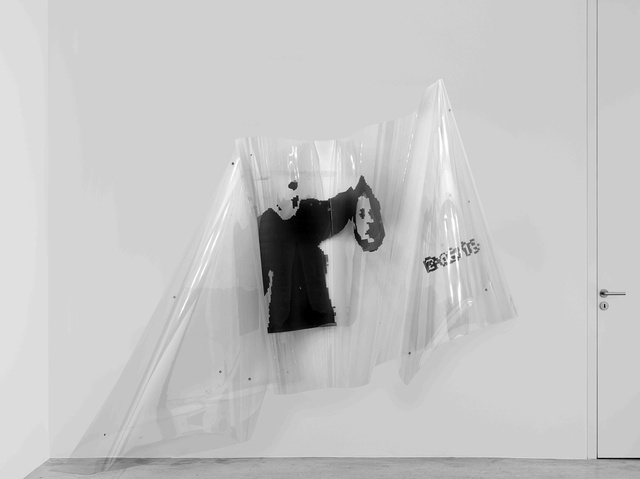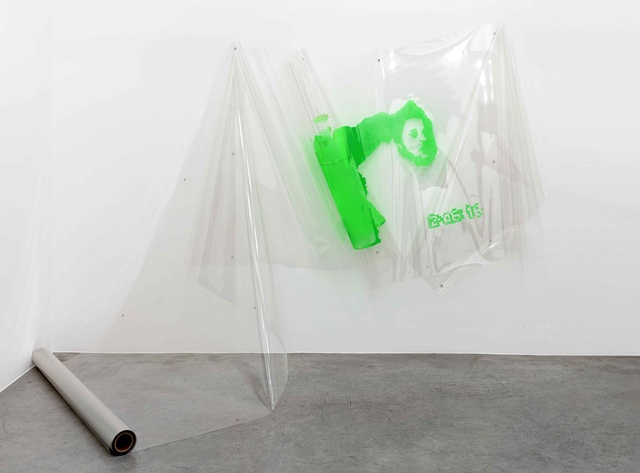Lecture on the Extra Part
If it can be said that Seth Price’s work depicts, it is foremost the picture’s own forces of dissemination, disintegration, and corruption that it shows. In preparing this issue, we asked Price about the role of the photographic (in its capacity to automatically generate images) in his art.
In turn, Price responded with a short history of magic, suggesting that photography’s origins lie not only in occult or spiritual practices, but also in their attendant need to capture society as an image. As his essay further proposes, it may not be a coincidence that procedures of organization and institutionalization and their consolidation in the modern world evolved in tandem with technological innovations: photography as a matter of faith, photography as an instrument of control.
“Magic has been around forever,” I said, “so let’s start at the beginning. For the sake of this lecture, let’s posit three ages of spirituality. The first age runs from the dawn of humanity onward, some x thousand years. We’ll call it the Shamanic Age. During this period, virtually all human practices would have fallen under the rubric of Magic. The world was magic, and everything in it. The trees had will, the air had power, the fire told stories. Or, alternately, your will was fire, your stories were as the air, and human power was a tree. Because everything was interchangeable with everything else. Which is a primal state many of us wish to return to, and may yet, thanks to digital technology.
Next comes the Pagan Age, which brings us up to the birth of Christ. Where shamanism was a loose, scattered phenomenon, paganism was more structured, with traditions and institutions. And this reaches a pretty sophisticated state with the Greco-Romans and the Egyptians. But in the centuries leading up to Christ you get a relatively quick, worldwide transition to the third age, the Monotheistic Age. What happens is, institutions stage what amounts to a hostile take-over of pagan ideas. They keep the structuring frameworks, but they get rid of multiple deities, and animal worship is tossed out, and nature worship is frowned upon. This is all a power move, because now they’re able to concentrate worship into singular prophets like Christ, and Mohammed, and Buddha. These guys function like bottlenecks, so that you can mediate a society’s desires through a priest class, which is itself hierarchical and controllable. So religion begins to act like a kind of photography, a way of freezing the spirit image: you have only to remember one thing, like praying, because the system manages the rest for you.
 Seth Price, „Hostage Video Still With Time Stamp,“ 2005
Seth Price, „Hostage Video Still With Time Stamp,“ 2005
The magical tradition we’re discussing today can be understood as a counter to the Monotheistic Age. It’s not that these people want a return to shamanism or paganism, they just don’t wish to operate within traditional institutions. They’re interested in the same concepts of growth and transformation, but they’re intentionally operating outside of the dominant traditions. They want full autonomy, right? To create their own imagery, and distribute as they see fit. I won’t go into all the magical figures and currents that emerge during the two thousand years after Christ, but obviously it was a pretty bad time to be interested in these kinds of things. I mean, it could get you tortured, or executed as a public example. Instead, let’s fast-forward through The Dark Ages and the Enlightenment to the late nineteenth century, which is when you get a huge resurgence of interest in all this stuff. There’s a great occult reawakening. You get people like Madame Blavatsky or Dion Fortune, these mystical figures trying to develop systemic thinking, who consequently attract acolytes. These people are heralding a new phase of magic, and it’s basically a Modernist phase, if you want to historicize it in academic terms. It’s certainly contemporaneous with what we call Modernity: the development of photography and cinema, and the modern city, and industrialization, and all the great relativist thinkers: Darwin and Freud, Marx or Nietzsche, even going into Duchamp. All of whom, by the way, would have been condemned as warlocks just two centuries earlier!
So magic starts modernizing, and rapidly. That means the growth of complex, usually urban, systems. Of course the irony is that they’re mirroring the church, though they’d probably want to trace it to the Freemasons. In London you get the Hermetic Order of The Golden Dawn, one of the most influential organizations ever. With The Golden Dawn, magic isn’t about some weird nineteenth century mystic like Gurdjieff, it’s an institutionalized structure, with a priesthood presiding over a series of levels that initiates have to ascend through. It has the so-called Secret Chiefs, who are supposedly these anonymous, all-powerful individuals that no one’s ever met, who may not even exist, who only priests can communicate with. I mean, what is that? Church, right?
Around this time you also get Aleister Crowley, the so-called Great Beast, and he’s this brilliant, ambiguous figure. You know: is he for real, or is he in it for the power trips and the girls? And that’s always the tricky role to play, this kind of knife’s edge between shaman and charlatan. It’s like Beuys, or Koons, these contemporary artists just daring you to believe their shtick. In some ways Crowley was still invested in traditional institutions, but the radical thing he introduces is the idea of Will. It’s an ancient idea, but he basically promotes the notion that every Magician should follow his or her own Will, which is elevated to almost a religious concept. His main precept goes, “Do what thou wilt shall be the whole of the law.” People who don’t know any better always assume this is an exhortation to anarchy and chaos, but that’s not true. There’s disagreement on the implications, but the key thing is that Will shifts the focus from the system to the individual. And this is Crowley’s real gift to Magic, or, as he spelled it, ‘Magick’ with a ‘k’. Will is what people fastened on to, the stubborn creation of something from nothing, like spelling Magick with a K. And of course this is what makes him so appealing to artists.
 Seth Price, „Hostage Video Still With Time Stamp,“ 2005
Seth Price, „Hostage Video Still With Time Stamp,“ 2005
Crowley dies in 1947, which is kind of a neat way to jump into the postwar era. By then you have the growing influence of Austin Osman Spare, who’s a fascinating figure. He was only a little younger than Crowley but he was really part of the new era, he marks a transition. Crowley was a man of the vanishing nineteenth century, even if he was a revolutionary. Spare, meanwhile, was this lone wolf, this uncompromising guy. He was a gifted artist, but one who didn’t make the grade, kind of like Hitler. He just did his lonely magical thing by himself in a garret, until he died. But his legend grew, because all by himself, or through his Will, he developed an internally cohesive system that people still use.
Probably his most notable development was “sigil magic.” Making a sigil means basically taking a word referring to something you want to control or effect, like, say, the name of an enemy, and compressing the letters into a kind of graphic monogram. It reduces material being to a compressed and graphic sign, which you can contemplate, or copy and distribute, or file away, or destroy. This little index becomes a concentrated expression of Will. And that’s part of the definition of magic, right? That all your power and energy is compressed into a singular image. Magic is a kind of system by which Will gets poured into an image. Of course that’s art, too. And you can think of Magic since Modernism as being in dialogue with the rise of image technology. Spare recognized that with Modernity it’s the material world that’s getting harder to substantiate, and that images can actually do that work for us.
So, Spare’s a total individualist, and in a way he leads to one of the more interesting recent developments, which is Chaos Magick. This starts to appear in the 1970s, “The ‘Me’ Decade,” which makes sense, because Chaos Magick is all about the individual, it’s opposed to top-down structures. If Crowley and all these hierarchical groups are Modernist, Chaos Magick is Post Modern. It’s decentralized, it’s schizophrenic, it’s horizontal, it sidesteps the hierarchy. Not only is there no system of priests and initiates, there’s not even a fixed belief system. You can be a Chaos Magician but also believe in Christ, and then you can disavow Christ tomorrow and declare your faith in Islam. Chaos Magick encourages eccentricity and anarchism, so of course it’s threatening to traditional magicians. Now, not coincidentally this is the time when network technology and personal computing appears, and you can just picture all these bearded, programmer longhairs walking around MIT or wherever, toting little sigils, trying to will a new world into being.” I stopped for a beat. “And you know what? They did.”
To weak and obliging laughter I unscrewed the cap of my water, gearing up for the next part of my lecture. A small voice rang out from the back of the room. “I’m sorry, but haven’t we left the monotheistic age? Isn’t it possible we’re already becoming something different?”
I considered the question. I found myself producing careful, almost defensive acknowledgments. “In one sense you’re right,” I said. “We live in an age when people cobble together a way of being that works for them, and it’s not a monotheistic way. You go to Episcopal Church on Sunday, you visit your acupuncturist on Tuesday, you get your palm read on Thursday.” I searched my conscience. Did I believe this? But the voice carried on as if I’d said nothing of consequence: “You also mentioned that digital technology might eventually allow us to return to a primal state.”
“I did. But, and this is a big but, only by obliterating differentiation. But also we can say, with Nietzsche, that science amounts to simply another, newer, faith. The world of technology offers a scaffolding for the same old questions, the same blind subject positions. And beyond that, you can say that we have Hollywood and celebrity culture and social media, and that our world of reproduced images is a new belief system.”
“No, no,” came the reply, “I’m not talking about any of that.”
“Aren’t you?” I said, suppressing irritation. “You’re claiming there’s a we that’s entered some new era, where the questions are all different, and everything moves through new channels. I don’t know if that’s the case. I don’t see that we’ve passed through any transition, or entered some other world.”
“Shamanism does speak of a journey into another world. But this is a vision only.” There was a pause. When the voice returned, it was a low whisper. “In this vision, my body is completely dismembered. Then it is reassembled. Afterward, I am able to go about my business again, only now my body has a small, extra part, like an extra bone.”
Notes
| [1] | Seth Price, „Hostage Video Still With Time Stamp,“ 2005 |

